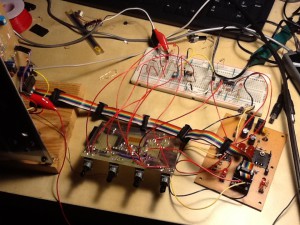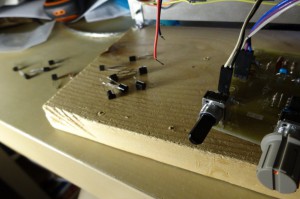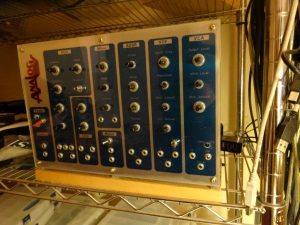I started prototyping my next envelope generator in parallel with the slow-moving VCA unit development. Unlike my previous envelope generators, this one will make envelopes by calculation instead of using an analog circuit. I’ll use microcontroller STM32C092KCT as usual that has a built-in CAN controller.

I expect several advantages with making an envelope generator using a microcontroller:
- Gate signals can be retrieved from the CAN bus; patching cables are not necessary for receiving gate signals
- Easy to support velocity
- Any curves are possible as long as the calculations catch up; it’s possible to do more than ADSR
- You can save and load parameters
I first implemented fundamental code for the CAN controller. I’ll make this part as a common Analog3 code library later. I then moved onto envelope generation. I start it with the traditional ADSR curves. The STM32C092 controller is missing FPU, so fixed-point calculation is necessary to generate envelopes with sufficient speed. I studied it before, read the article to remember how:
OK now I remember. Calculating an exponential curve is simple; you just repeat next = r * prev where 0 <= r < 1. A more complicated issue is how to calculate the value of decaying ratio r from the knob position k. I tried to map knob position k to decaying ratio r through the curve’s time constant τ. A exponentially-decaying curve can be described as following:
The decaying ratio r is a ratio of values between a small time difference Δt:
Mapping the knob position to time constant should not be linear for a natural operation feeling. I first try exponential curve as following:
Then the relationship between k and r is
which is a bit complex to calculate. But I’ll use this equation for a while until the algorithm to generate envelope becomes clearer. In the equation above, constants α and β are unknown yet. They decide the range of time constants, so I’ll find a suitable pair for comfortable ADSR control by experimentation. I used gnuplot to decide initial values roughly as α = 0.00015 and β = 7.5 with k range 0 to 65535:
gnuplot> plot [k=0:65535] exp(k * 0.00015 - 7.5)Then the decaying ratio to the knob positions with updating interval 1ms looks
gnuplot> plot [r=0:65535] exp(-1.e-3/(exp(r * 0.000115 - 7.5)))
The values get close to 1.0 as the time constant grows. For the shortest time constant, the ratio is less than 0.2 where I expect the generated curve being unnatural. So I presume shorter updating interval is necessary.
to be continued…






